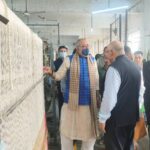Smart Phones Sort Used Clothing By Fibre Before Recycling

Researchers at Germany based Fraunhofer IPMS have developed an ultra-compact near-infrared spectrometer which is suitable for recognising and analysing textile fabrics meant for recycling.
Fabrics whether made from pure cotton or blended can also be reliably identified through the combination of imaging, artificial intelligence algorithms and spectroscopy.
The researchers said the technology could be used to optimise recycling old garments and sort them as per the fibre.
The spectrometer is so tiny that it can be integrated even into a smart phone and this could help in more applications including checking clothes when shopping or detecting counterfeits.
Researchers at Fraunhofer rely on near-infrared spectroscopy to achieve the required reliability and accuracy when identifying textiles.
“We combine NIR spectroscopy with imaging and AI to achieve higher accuracy when recognizing and analyzing objects,” said Dr. Heinrich Grüger, Scientist in the Sensoric Micromodules department at IPMS.
Firstly, a conventional camera module captures an image of the garment then the AI selects a specific point from the fabric’s image data to be examined by the spectral analyser module.
Light reflected from the fabric is captured by the spectrometer module and it then passes through an entrance slit and is transformed into parallel light beams and projected onto a grating using a scanning mirror.
Depending on the angle of incidence and exit, the grating splits the light beams into different wavelengths.
Light reflected from the grating is directed by the scanner mirror to a detector which captures the light as an electrical signal.
A converter then digitises these signals, which are subsequently analysed in the signal processor. The resulting spectrometric profile for the textile fabric reveals which fibres it is made from by comparing to a reference database.















